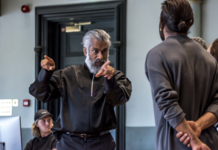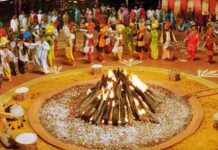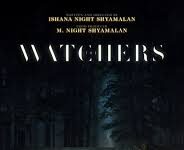How Wes Anderson took India to Hollywood
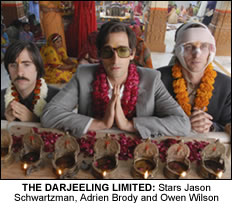 Wes Anderson’s The Darjeeling Limited, releasing this week across the UK, tells the story of a reunion between three brothers – Owen Wilson, Adrien Brody and Jason Schwartzman – who set off on a train journey across India in an all new bonding process.
Wes Anderson’s The Darjeeling Limited, releasing this week across the UK, tells the story of a reunion between three brothers – Owen Wilson, Adrien Brody and Jason Schwartzman – who set off on a train journey across India in an all new bonding process.
With the creative minds behind India’s Bollywood blockbuster machine increasingly searching the world for locations, it has been left up to Wes Anderson to bring India to the big screen.
But just what was it about India that made it so appealing to one of Hollywood’s most aspiring filmmakers?
Known for his penchant for design and imaginative sets, Wes Anderson makes a visual departure with The Darjeeling Limited, while still bringing an intrinsic sense of whimsical choreography to the Whitman brothers’ unfolding journey through India.
The idea was to take India as it is and meld that, bit by bit and moment by moment, into the almost claustrophobically private world of the three brothers – letting the two collide in a kind of controlled chaos.
“I’m used to the set design in my films coming from my imagination or different influences combined with my imagination,” explains the director, “but in India, it was a different case. There was so much to surprise you in every direction you might look. There was always something funny or something strange and we wanted to capture it all — and the challenge was getting as much of that as possible into the movie we had written.”
The task began with Anderson setting forth the modus operandi of “shooting as organically as possible,” explains cinematographer Robert Yeoman, who has worked with Anderson on all of his films and also recently shot Noah Baumbach’s The Squid and the Whale. For Yeoman, India provided both a thrilling and challenging locale for following that mandate. “India is a country of such great contrasts – extreme poverty and great wealth, squalid streets and lavish temples. Above all there is an energy that permeates everything and is inescapable,” he says.
Then there were the crowds. “Shooting on the streets of India is somewhat uncontrollable and the sight of a camera will always draw people,” notes Yeoman. “Wes likes to carefully place each of his actors in the frame but we often had to deal with spectators in the background. By working quickly, often with no lights for day scenes, we tried to take advantage of all this randomness and hopefully, there is a particular energy to our shots imparted by all the unpredictability.”
This approach also extended to the production design. Says Mark Friedberg: “The idea was always to let India be India and to embrace odd circumstances or ‘mistakes’ as they happened. Aside from the train, we wanted the film to feel organic, even though most of the sets were very carefully designed. And because Wes is such an analog person who would never use computer-generated imagery or anything like that, who likes handmade styles and traditional technologies, India was really the perfect place for him to work.”
Adds the film’s graphic artist Mark Pollard: “India strips everyone of their preconceptions, and presents you with chaos, anarchy, spirituality, prayer and beauty. Just as it’s a great place for the characters in the film to experience life, it was for all of us who were there.”
Friedberg, who previously worked with Mira Nair in India on the lavish Kama Sutra, notes that Anderson’s view of India is a distinctive one in cinema — that of an enthusiastic outsider. Anderson peers in with all the exhilaration and wonder of a first-timer into this remarkable culture, yet with a keen eye for that twinge of heartbreak and comedy lurking around each corner. “Wes was actually writing his everyday experiences in the country into the script even as they occurred,” notes Friedberg.
The film was shot primarily in the palace-lined, desert region of Rajasthan in the Northwest corner of the sub-continent, with The Darjeeling Limited itself moving on tracks that ran from the vivid city of Jodhpur all the way to Jaisalmer, in the Thar Desert, near the Pakistani border. Meanwhile Patricia’s convent and orphanage were created in lusher, greener Udaipur, in a former royal hunting lodge that once belonged to the Maharana of Mewar, one of the Rajput era rulers.
For the convent, Friedberg looked at the legendary 1947 Michael Powell film Black Narcissus, which also takes place in a nunnery in the Himalayas. “The location needed to feel both remote and dramatic, and it did,” says the designer. “In terms of detail, we were interested in cultural fusion. We let the retrofitted palace define the idea, but since the English Empire brought Christianity to India, we used a lot of those relics as set dressing.”
One of the film’s most moving sequences unfolds in a rural village in the Rajasthan desert, after the Whitman brothers run into trouble in the rapids of a river. Here, too, Anderson mixed the authentically real and the intently cinematic. The sequence was shot largely with the real villagers in their own clothing and houses with no changes. Yet, the approach was hardly that of a documentary as Anderson explains: “We shot the people as they were but we also shot it as I would shoot anything: with lots of complex staging and dollies and people being cued. So it was a case of inviting the real people of this village into the ongoing story.”
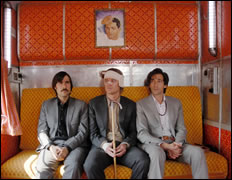 This style of merging “found” images with Anderson’s more complex visual choreography continued throughout the film. “We approached much of the film design, outside of the train and the convent, as a collage,” comments Friedberg. “For example, for our market shots, I collected a bunch of vendors from disparate parts of the market and brought them all together to make a kind of greatest-hits market scene.”
This style of merging “found” images with Anderson’s more complex visual choreography continued throughout the film. “We approached much of the film design, outside of the train and the convent, as a collage,” comments Friedberg. “For example, for our market shots, I collected a bunch of vendors from disparate parts of the market and brought them all together to make a kind of greatest-hits market scene.”
Producer Lydia Dean Pilcher has worked in India before, but notes that Wes Anderson brought a perspective she hasn’t previously seen. “He has this way of sort of penetrating the mysterious in very subtle ways,” she observes. “So instead of this sort of cacophonous, populous and dense imagery often associated with India’s urban environments, he captures more of the serenity and spirituality of the culture and the vastness of the landscape. Travelling on this journey of making the film was both a unique trip through India – and a chance to live in the distinctive rhythm of Wes’s world.”
Also collaborating for a second time with Wes Anderson is three-time Academy Award winning costume designer Milena Canonero. Fresh off winning an Oscar for her lavish, candy-colored designs for Sofia Coppola’s Marie Antoinette, Canonero faced a simpler, but compelling task in establishing the distinctive yet related look of each Whitman brother.
Adding to the design are the brothers’ suitcases, the baggage they’ve literally inherited from their father, which figure prominently in the story. To create something that would be emblematic of the Whitman family, Wes Anderson recruited designer Marc Jacobs on behalf of the design house Louis Vuitton to produce a special, one-edition set of luggage just for the occasion. “They make the best suitcases, and I say that because I watched how they made these, putting in hundreds of little nails and making them so carefully and intricately,” says Anderson. “They were made so well that we were able to drag them around the desert and have them fall in the river and throw them onto trains and have them really take a beating and yet, still they lasted. We only had the one set so it would have been a big problem if they were destroyed.”
Yet for all the master artists and craftsmen who worked on the film, Anderson notes that the real key to it was the minimalist spirit behind it. “We had wonderful designs and designers behind it all, but on the set, we didn’t have trailers, we didn’t have makeup people (even though our usual make-up artist Frances Hannon did do something special with Owen’s look) or wardrobe people or any of that. We were all in India living in a house together and everyone just completely threw themselves into the experience. And the best thing that could have happened on this movie did – the actors all became best friends and it was as if they were really in the story, which was the inspiration for all of us.”
The Darjeeling Limited is released nationwide on 23 November 2007.

